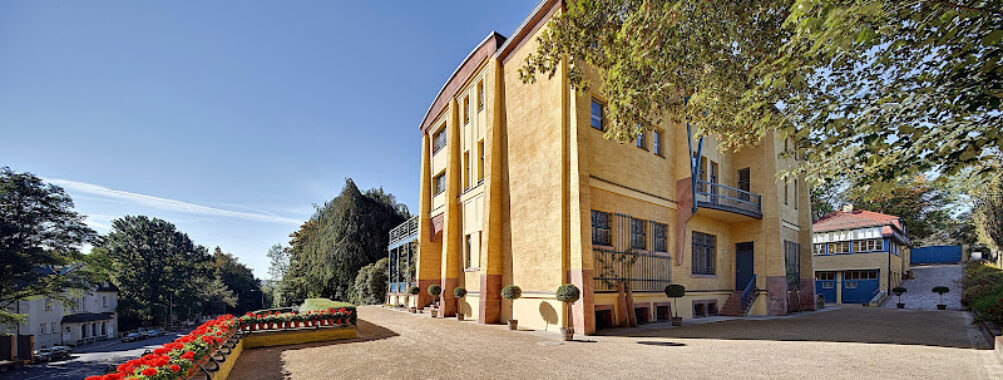
Villa Esche
Table of Contents
Description
Villa Esche in Chemnitz, Germany, is a truly fascinating destination for travelers with an interest in architecture, art, and history. Built in the early 1900s for textile manufacturer Herbert Esche, this house is one of the most well-known buildings designed by Belgian architect Henry van de Velde, a pioneer of Art Nouveau design. It is often regarded as a symbol of modern German architecture and design from that era. Visitors who step inside are immediately struck by the harmony of form and function—every curve, material, and detail was carefully thought out to create both beauty and practicality. What’s remarkable is not just the architecture itself, but also the fact that so much of the original design has been preserved, giving you a glimpse of how wealthy families of the time lived in spaces influenced by cutting-edge artistic movements.
Today, the villa is more than just a museum; it doubles as an event venue and cultural hub. The interior is home to permanent exhibitions connected to the Kunstsammlungen Chemnitz (the local art collections), and it often hosts concerts, conferences, guided tours, and special events. The dining experience here has also become quite well-regarded, making it not just a place to appreciate visual art, but culinary art as well. As with many historical sites, experiences can vary. Some visitors are overwhelmed by the beauty of the architecture and the unique atmosphere, while others feel the exhibition content could be a little deeper. Still, it’s undeniable that the building itself is the star of the show and a must-see for anyone who values architectural history.
Key Features
- Designed by Henry van de Velde, a leading figure in the international Art Nouveau movement
- Combination of museum and event venue, housing exhibitions, concerts, and conferences
- Beautifully preserved original interiors featuring Van de Velde’s signature design style
- Restaurant Villa Esche offering refined dining experiences with a focus on German cuisine
- Wheelchair accessible entrance, parking, and restrooms, plus assistive hearing loop available
- Free parking lot for visitors
- Guided tours available for those wanting a deeper understanding of the villa’s history and design
- Cultural programs linked with the Kunstsammlungen Chemnitz collections
Best Time to Visit
Choosing the right season can make a big difference with a visit to Villa Esche. In the spring and summer, the grounds are especially appealing—you can enjoy not just the building but also the leafy surroundings that almost feel like an extension of the architecture itself. The warm months are also popular for weddings and outdoor events hosted at the villa, which adds to the overall excitement. Autumn, with its changing colors, brings a different kind of romance and pairs beautifully with the warm interiors of the home.
Winter has its own charm. I visited in late November once, and the low light through the villa’s windows made the spaces feel intimate and deeply atmospheric. Sure, the garden isn’t as green then, but seeing Art Nouveau details under soft winter light made the trip unforgettable. So really, there’s no such thing as a bad time—the key thing is to book in advance if you’re heading during holidays or event-heavy weekends.
How to Get There
Villa Esche is easily accessible within Chemnitz, which itself is a well-connected city in Saxony. If you’re coming by train, Chemnitz has direct connections from major German cities like Dresden and Leipzig. From the central station, it’s a short car ride or tram journey to reach the villa. Public transport around the city is reliable, and local trams and buses have stops fairly close by. Driving in is also straightforward, and since there’s a free parking lot available, you won’t stress over finding a spot. For those staying in central Chemnitz, a walk or bicycle ride is also doable if you don’t mind stretching your legs—roughly 20–30 minutes from the city center depending on your pace.
Tips for Visiting
First and foremost: if you’re into architecture or design, give yourself plenty of time here. The villa isn’t massive like a palace, but there are so many fine details to appreciate in Van de Velde’s work that you’ll want to linger. Going with a guided tour is highly recommended, as guides point out hidden features you might otherwise miss.
Pairing your visit with a meal at the Restaurant Villa Esche is also a smart move. It’s not just about the food (which is well-made German cuisine presented in a refined manner), but also about enjoying a dining experience inside a space shaped by one of the greatest designers of his time. You won’t find ambiance like this at an ordinary restaurant in town.
Accessibility is generally good—wheelchair users and those with mobility needs should feel comfortable here thanks to thoughtful features. And, if you’re coming with kids, you may want to set expectations right: while older children with an interest in history or architecture might enjoy learning something new, very young kids may find the formal interior less engaging.
Lastly, if you love photography, prepare yourself. The villa is a dream for anyone who enjoys architectural shots, but be mindful of rules about interior photography—at times it may be limited or require permission. For a stress-free experience, check in advance about opening hours and any special events that might close the villa to tourists. On the practical side of things, payments are made easy as both credit and debit cards are accepted, which is always a relief traveling around Germany where card acceptance isn’t universal.
All in all, Villa Esche in Chemnitz manages to fuse history, culture, and a touch of modern hospitality in one beautiful package. Whether you come for the architecture, the exhibitions, or just to dine in a space soaked in design history, it’s definitely a place that adds real value to a trip through Saxony.
Location
Places to Stay Near Villa Esche
Find and Book a Tour
Explore More Travel Guides
No reviews found! Be the first to review!